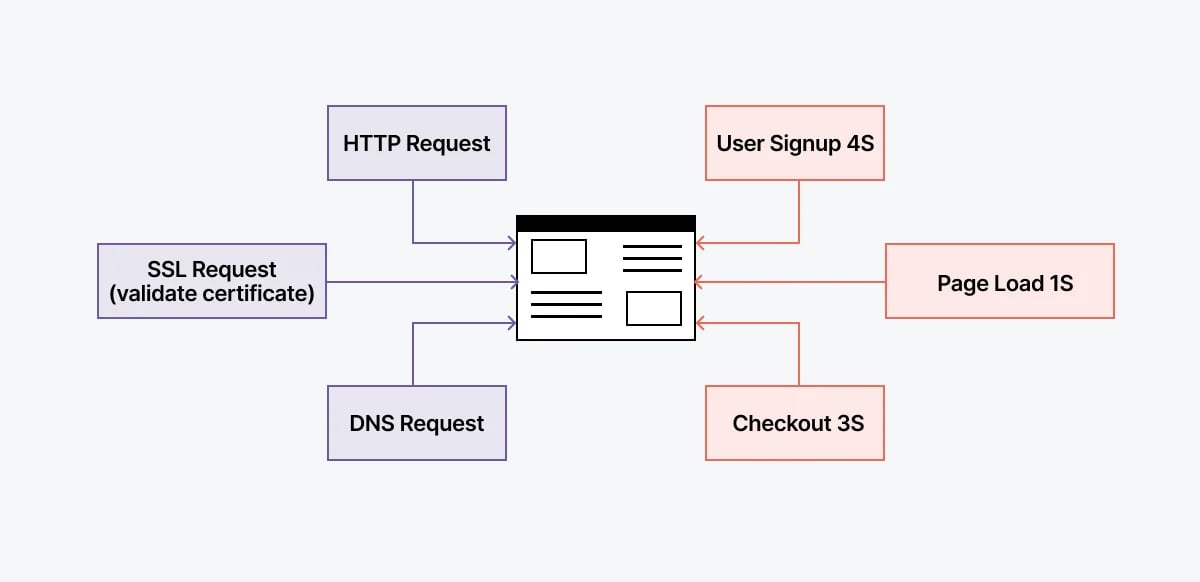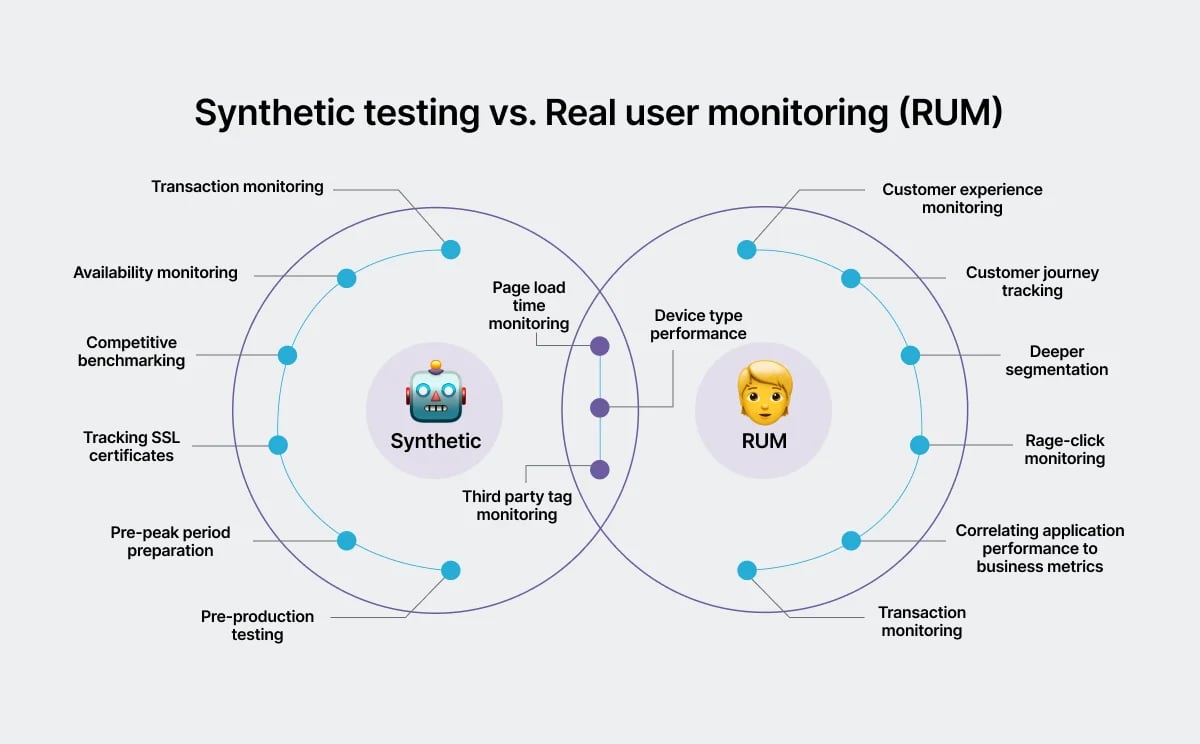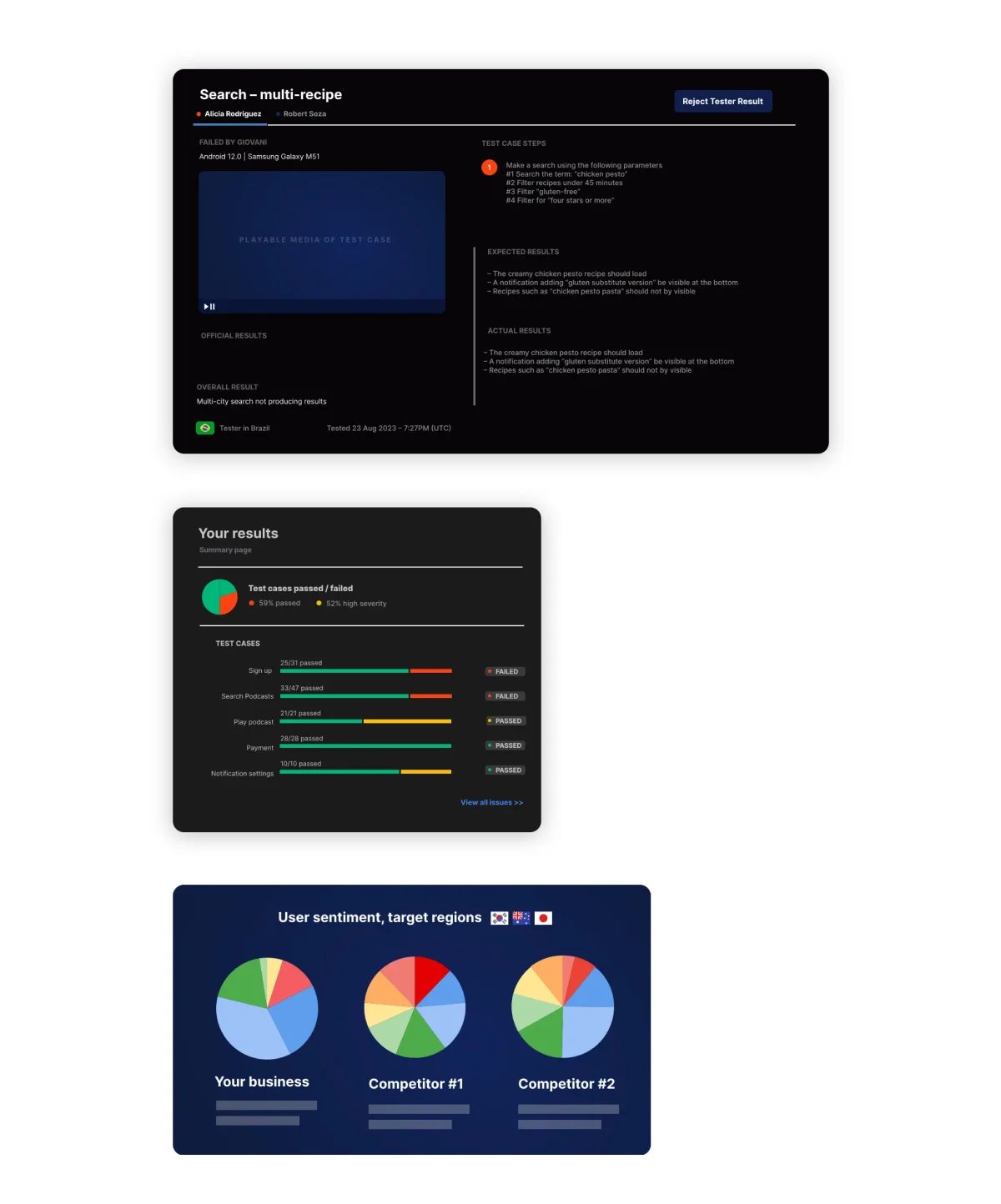Synthetic testing: what it is & how it works
Synthetic testing or synthetic monitoring, involves simulating real user traffic to find performance issues in key user journeys. Companies use this type of testing to actively monitor service availability, application response times, and the functionality of customer transactions. This guide covers everything you need to know to perform synthetic testing. Let's begin.
We can help you drive synthetic testing as a key initiative aligned to your business goals
What is synthetic testing, and why is it important?
Synthetic testing is a software testing approach that involves simulating real-world scenarios to evaluate the performance of a system or application. It is becoming increasingly important in today's software development because enterprises need to deliver software faster while ensuring high quality and reliability. Here are some of the reasons why:
- It helps identify and detect potential issues before they become significant problems.
- Ensures application reliability and improves user experience.
- Provides performance benchmarks to help optimize system performance and scalability.
- Minimizes downtime due to application failures.
- It helps companies meet service level agreements (SLAs) and avoid reputational damage due to poor application performance or outages.
How does synthetic testing work?
Synthetic testing is typically an automated technique used to evaluate the performance and functionality of a software system or application. It simulates user behavior by creating virtual requests and measuring the response time, scalability, and other performance indicators. Synthetic tests are created using scripts defining user actions, such as clicking links, filling in forms, and checking response times. These scripts can be run repeatedly to check the consistency of the test results.

However, synthetic testing can be conducted manually, especially during the initial stages of testing or when verifying specific user journeys or edge cases. Manual testing may validate automated test results or assess scenarios requiring human judgment or creativity.
Benefits of synthetic testing
Let’s explore the benefits of synthetic testing in more detail.
1. Identify performance problems early
By conducting synthetic testing early in the software development lifecycle, developers can identify and address potential issues before they become significant problems. Thus, synthetic testing can lead to high-quality and reliable software that meets user expectations.
2. Expand into new markets confidently
When simulating real-world scenarios across different geographic locations, companies can ensure their applications are ready for use in new markets. This preparation allows for confident expansion, minimizing the risk of application failures or downtime.
3. Enable frequent code deployment
Synthetic testing detects potential performance issues and ensures code changes don't negatively impact application performance. This facilitates frequent code deployment, allowing companies to introduce new features and updates rapidly while maintaining software quality and reliability.
4. Shorten mean time to resolution (MTTR)
Quickly detecting and diagnosing performance problems helps developers resolve issues more swiftly. This reduces the mean time to resolution (MTTR), minimizing downtime and keeping applications available and operational.
5. Consistently meet performance standards
Maintaining optimal application performance under different conditions is key to meeting performance standards consistently. That way, companies can deliver high-quality and reliable software, giving them a competitive edge.
6. Achieve performance targets efficiently
Establishing performance benchmarks and optimizing system performance allows companies to meet performance targets effectively. Also, it ensures that applications remain performant even under heavy traffic loads.
7. Support agile development practices
Synthetic testing fosters agile development practices by enabling continuous testing and quick, reliable feedback to developers. This enhances software quality while enabling faster releases and shorter development cycles.
Challenges of synthetic testing
Despite its benefits, synthetic testing also presents several challenges that should be addressed to ensure optimal results.
1. Complexity in test case design
Creating test cases that cover all possible user actions and scenarios can be challenging, particularly for complex applications. One way to address this challenge is to use capture and playback tools that record user actions and convert them into test cases. However, this approach may not reflect the behavior of actual users, and the test cases could miss critical scenarios.
2. Maintaining up-to-date test scripts
Test scripts should be updated regularly to reflect changes in the application or system under test. For instance, a change in the user interface or application flow may require modifications to the test scripts. Failure to update the test scripts can lead to errors and inaccurate results.
3. Handling dynamic content
Synthetic testing can struggle with dynamic content, such as generated data that changes frequently and needs to be captured correctly in test cases. For example, suppose an application generates user IDs, transaction numbers, or timestamps. In that case, synthetic tests must account for such dynamic content to ensure accuracy.
4. Test data management
The quality and accuracy of the test data can impact the results of synthetic testing; thus, the management and organization of test data are crucial. The test data used in synthetic testing should practically represent the actual data used in the live environment. Poorly managed test data can lead to test case failures and errors.
5. Integration with other tools and systems
Synthetic testing should be integrated with other tools, systems, and workflows for automated continuous testing. Integration with other systems can provide a better view of the application's performance and enhance the accuracy of testing results. However, integrating multiple test tools can also present challenges, such as compatibility issues, data storage problems, and management problems.
Types of synthetic testing
The two main classes of synthetic testing are:
- Browser tests: Browser tests simulate user interactions and behaviors within a web application using browsers. This type of testing examines the end-to-end experience, including page load times, rendering, and responsiveness across different browsers and devices.
- API tests: API tests evaluate the application's APIs' performance, functionality, and reliability. This includes testing API endpoints for expected responses, data integrity, and response times under various conditions.
Synthetic testing vs. Real user monitoring (RUM)
Synthetic testing and real user monitoring (RUM) are two approaches to evaluating a software application's performance. Synthetic testing involves simulating user actions and behavior to test the application's functionality, performance, and security. In contrast, RUM involves monitoring interactions with the application in real time.

Synthetic testing requirements
Several requirements are essential for performing synthetic testing effectively.
- The test environment must simulate the actual live environment to ensure accurate results.
- The test data used must be realistic, relevant, and up-to-date.
- Test scripts should be well-structured, covering all possible user actions and scenarios.
- The testing tools must be efficient, accurate, and support different types of testing.
- The testing process must be based on relevant metrics that allow the team to track and analyze the performance data.
- The testing team must be skilled and experienced in synthetic testing to ensure proper execution and interpretation of results.
- A well-structured test execution plan that covers all scenarios and aspects of the application is crucial for achieving useful results.
Synthetic testing best practices
Here are 15 synthetic testing best practices that you can consider:
- Clearly define the objectives of the testing process to ensure that they align with business goals and objectives.
- Choose reliable, up-to-date, and scalable testing tools compatible with other tools and systems.
- Implement version control systems to manage changes to test data and scripts and ensure consistency across test cycles.
- Develop scripted tests with a clear and concise structure to reduce the effort and time needed to maintain those scripts.
- Automate test cases where possible to improve the efficiency and reliability of the testing process.
- Develop test cases that cover different scenarios, including negative testing, edge testing, and expected outcome testing.
- The test data used in synthetic testing should mimic actual data, including variation, complexity, and sensitivity.
- Prioritize test cases based on the risk levels of the corresponding functionalities to enhance test efficiency.
- Incorporate continuous testing into the software development lifecycle to ensure ongoing performance monitoring and issue detection.
- Monitor test results regularly to identify performance issues or bugs; assess results for patterns and trends that may go unnoticed.
- Validating test results against multiple sources, including user feedback, monitoring tools, and other industry benchmarks, ensures consistency and maturity.
- Collaboration across teams, including development, testing, and product, can help establish common goals and prioritize testing efforts.
- Partner with external testing services to supplement in-house testing resources and support better coverage.
- Set up standardized test practices within the organization to ensure the test results' consistency, repeatability, and accuracy.
- Regularly assess and improve testing processes to align with evolving business needs and adopt the latest practices and technologies.
Synthetic testing examples
Example 1: Simulating a user login journey
Objective: To test the entire user login process, from entering credentials to accessing the account dashboard.
Steps:
- Simulate a user entering a username and password.
- Submit the login form and navigate to the account dashboard.
- Verify successful login by checking for a welcome message or account details on the dashboard.
Expected result: The application should authenticate the user and provide access to the account dashboard without any delays or errors.
Example 2: Testing the e-commerce checkout process
Objective: To ensure the checkout process in an e-commerce application functions smoothly and accurately.
Steps:
- Simulate adding items to the cart.
- Navigate through the checkout process.
- Complete a purchase by providing payment and shipping information.
Expected result: The application should successfully process the purchase and provide a confirmation message and receipt to the user.
Example 3: Verifying API response times
Objective: To assess the responsiveness of an API by measuring the time it takes to respond to requests.
Steps:
- Send a series of API requests to various endpoints.
- Measure the response times for each request.
- Compare the response times against acceptable time frames.
Expected result: All API endpoints should respond within acceptable time frames, ensuring a smooth experience for users relying on the API.
How can Global App Testing assist with synthetic testing?
Global App Testing excels in synthetic testing through its extensive network of skilled testers and broad device coverage. Its user-friendly platform efficiently identifies and resolves app bugs, providing insights and reports that enhance testing. Moreover, the platform offers distinctive features that further elevate the value of synthetic testing:
Easy-to-use platform:
- Our user-friendly platform integrates with your development workflow, boosting overall efficiency.
- Utilize a centralized dashboard to easily manage testing projects, track progress, and interact with testers, fostering collaboration.
- Gain insights into each identified bug's context and benefit from visual evidence for a clearer understanding of issues.

Fast and dependable services:
- Our 24/7 service guarantees prompt delivery of test results within 6 to 48 hours, meeting urgent testing demands and supporting overnight launches.
Worldwide user feedback:
- Leverage a network of over 90,000 testers across more than 190+ countries, offering diverse perspectives and thorough testing on a global scale.
Quality assurance:
- We employ various testing methodologies to ensure product quality and reliability, including functional, compatibility, usability, and performance testing.
And extra:
- Explore a wealth of guides, webinars, and articles to help you adopt and understand the best practices in performance testing.
Want to learn more? Sign up now to schedule a quick call today!
We can help you drive synthetic testing as a key initiative aligned to your business goals
Keep learning
9 Performance testing types: key benefits & examples
How to perform manual mobile testing
The only functional testing checklist you need

